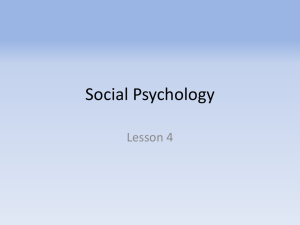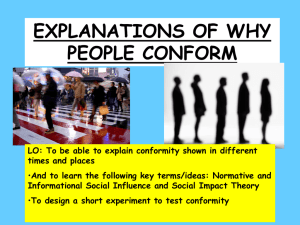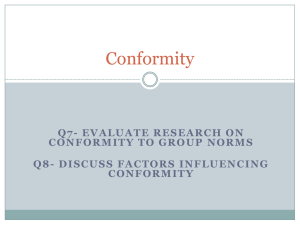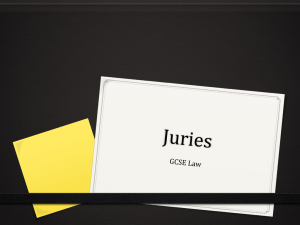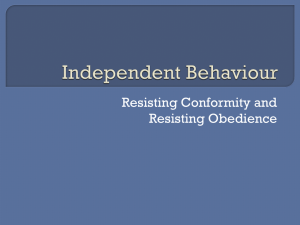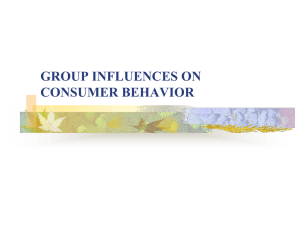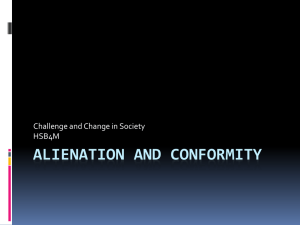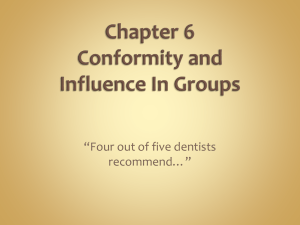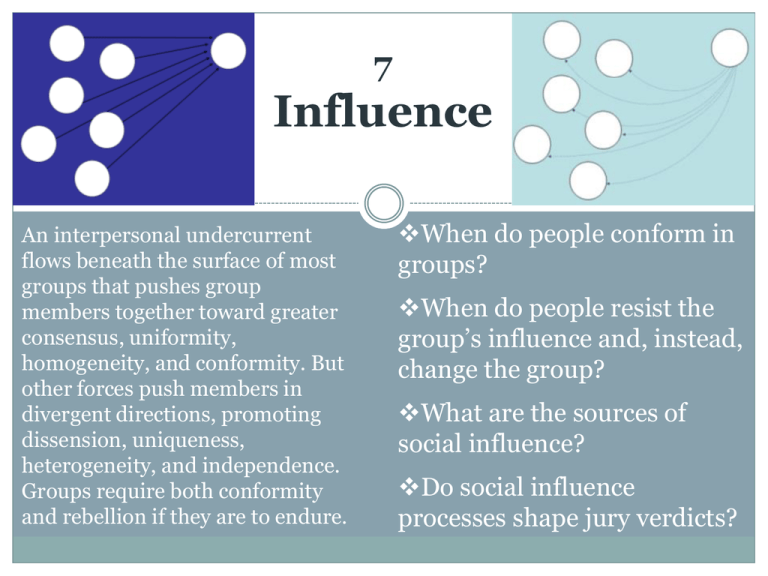
7
Influence
An interpersonal undercurrent
flows beneath the surface of most
groups that pushes group
members together toward greater
consensus, uniformity,
homogeneity, and conformity. But
other forces push members in
divergent directions, promoting
dissension, uniqueness,
heterogeneity, and independence.
Groups require both conformity
and rebellion if they are to endure.
When do people conform in
groups?
When do people resist the
group’s influence and, instead,
change the group?
What are the sources of
social influence?
Do social influence
processes shape jury verdicts?
Majority
Influence
Conformity &
Independence
Conformity across
Contexts
Who Will
Conform?
Minority
Influence
Sources of
Influence
Conversion
Theory
Implicit
Influence
Predicting Minority
Influence
Informational
Influence
Normative
Influence
Dynamic Social
Impact Theory
Interpersonal
Influence
When Influence
Inhibits: The
Bystander Effect
Application:
Juries
Jury
Dynamics
How Effective
are Juries?
Improving
Juries
Majority
Influence
We are discreet sheep; we wait to see how
the drove is going, and then go with the
drove.
--Mark Twain
Influence comes from the
word influentia: an ethereal
fluid that flowed down from
the planets and the stars to
affect human actions.
Unseen and unnoticed, influentia was
thought to subtly push humans in one
direction or another without completely
controlling them.
But influence
comes not from
planets, but from
people.
• Social influence
• Majority influence
• Minority influence
Pressure of
Many against
One:
Majority
Influence
Minority Influence:
Pressure of
One against Many
Ralph Waldo
Emerson:
"I must be myself. I
will not hide any
taste or aversions."
Asch’s studies of conformity
(1926, p. 53)
Conformity:
Changing one’s
thoughts,
feelings, and
behavior to
match the
thoughts,
feelings, and
behavior of
other people
When will a
person bend to
the pressure of
the group?
Conformity &
Independence
Example of the
“stimulus lines”
1
Standard Line
2
3
Comparison Lines
Trial 1
Trial 2
1
Standard Line
2
3
Comparison Lines
Results: people conform even on this easy task
Evidence of conversion,
compliance, and independence
(nonconformity)
Conformity &
Independence
Social
Influence
Compliance
The
Individual
Conversion (private
acceptance)
Independence
Anticonformity
Congruence—agree, but did so before influence
Conformity across
Contexts
Factors that
influence
levels of
conformity:
• Unanimity of
majority
• Another
dissenter (even
if incorrect)
• Strong vs. weak
situations (e.g.,
face-to-face,
remote)
• Size of the
group
Conformity across
Contexts
Factors that
influence
levels of
conformity:
• Unanimity of
majority
• Another
dissenter (even
if incorrect)
• Strong vs. weak
situations (e.g.,
face-to-face,
remote)
• Size of the
group
Conformity across
Contexts
Situational factors and
conformity
• Accuracy needs
• Cohesion
• Task difficulty
• Status of other members
• Social impact theory
stresses 3 key factors:
strength, immediacy,
and number (Latané,
1981)
Other studies find
variations in rates
across situations
Social Identity Model of
Deindividuation Effects
(SIDE)
• Individuals
interacting online
also conform, even
though anonymous
and remotely located
• Conformity and viral
online processes
Who Will
Conform?
Individual differences
in conformity
• Conformists,
counterconformists,
independents
• Cultural effects
• Cohorts
• Sex differences
Other studies find
variations in rates
across people
When Do People Resist
the Group's Influence
and Instead Change the
Group?
Moscovici’s
studies of
minority
influence:
Pressure of
One against
Many
Minority
Conversion
Theory
Influence
Behaviorally consistent
minorities sometimes
change the majority
Expanding minorities
are more influential
Minority influence is
more indirect than
majority influence, so
generates conversion
and innovation rather
than compliance
Reversing Asch: Moscovici’s
study of a consistent
minority
Predicting
Minority Influence
Consistency: Moscovici suggests a behaviorally
consistent minority is most effective
Status: Hollander argues minorities that are
accorded high status in the group are most effective,
for their idiosyncrasy credits protect them from
sanctions
Effort: Minorities exert more effort in their
attempts to influence than do majorities
Decision rules: A majority-rules decision rules
favors majority influence, a unanimity rule
minorities
Dynamic Social
Impact Theory
Latané’s dynamic social impact theory identifies four additional
processes:
Consolidation
Clustering
Correlation
Continuing diversity
Source: Latane & L’Herrou, Spatial Clustering, JPSP, 1996
Implicit
Influence
Implicit influence is produced by
cognitive, emotional, and behavioral
processes that are neither
consciously controlled nor frequently
noticed.
Group members tend to mimic
each other, without realizing they
are doing so.
Langer suggests that mindlessness
can cause individuals to conform
automatically.
Langer's photocopy study of mindlessness: Results
100
90
80
70
60
50
40
30
20
10
0
Control
Rush
Need copies
If 20 copies little compliance
Informational
Influence
When members use others’ responses
as reference points and informational
resources.
Social comparison theory:
basing conclusions on others’
responses
False consensus: misjudging the
extent to which others agree
Dual process theories : members
base choices on available
information (direct process) or
nonrational processes, such as
heuristics and emotional responses
(indirect process).
Normative
Influence
Members feel, think, and act in ways that
are consistent with their group’s social
standards
Disagreeing with others can trigger
cognitive dissonance, an unpleasant
and neurologically detectable
psychological state that individuals are
motivated to reduce.
Cialdini’s focus theory of normative
influence: norms are a more potent
and longer-lasting form of influence
than informational influence.
Interpersonal
Influence
Verbal and nonverbal tactics
(pressure) designed to induce change.
Schachter’s analysis of group rejection
indicates that a nonconformist is generally
less liked by others in the group.
Communication with a disliked deviant
eventually diminishes, at least when
cohesive groups are working on relevant
tasks.
Any dissent from the group mode will
reduce likeability.
Communication rate
Schachter’s study of
reactions to group
deviance
To most
deviates
To excluded
deviants*
To the mode
To the slider
Time
* very rare: cohesive, task relevant groups only that disliked deviant
Interpersonal
Influence
Subjective group
dynamics: Intuitive
beliefs about group
processes; members who
violate norms can trigger
the black-sheep effect—
they will be evaluated more
negatively than an
individual who is not a
group member who
performs the same type of
action.
Normative conflict
model: strongly identified
members are more willing
to bear social costs
associated with dissent in
order to improve group
outcomes.
When Influence
Inhibits: The
Bystander Effect
People help less when in
groups rather than alone
The Kitty Genovese Tragedy
In 1964 Winston Moseley attacked a young women,
Katherine (Kitty) Genovese as she returned to her
apartment after working. When one of her neighbors
shouted at him Moseley retreated to his car. But no one
called the police, and Moseley returned 20 minutes
later to renew his attack. He raped her and stabbed her
to death. The police receive the first call from a witness
at 3:50. They are on the scene in two minutes, but 37
minutes after the first attack. Journalists who
described the incident claimed that as many as 38
people witnessed the murder.
Rachel Manning, Mark Levine, and Alan
Collins (2007) point out that the Kitty
Genovese is something of a parable.
What causes the bystander effect?
Multiple causes
• Informational
influence
• Normative
influence (helping is
“normal” in sympatico
cultures)
• Diffusion of
responsibility
“Diffusion of responsibility” seems the
most likely explanation for this result. If an
individual is alone when he notices an
emergency, he is solely responsible for
coping with it. If he believes others are
also present, he may feel that his own
responsibility for taking action is lessened,
making him less likely to help.
Darley and Latane analysis
of reactions to emergencies
(1968)
Groups have served as the final arbiter of
guilt and innocence for centuries. As far back
as the eleventh century, the neighbors of
those accused of wrongdoing provided
information about the actions of the accused
and weighed the evidence. Witnesses and
experts now provide the evidence, and a jury
is responsible for weighing the testimony of
each person before rendering a verdict. More
than 300,000 juries convene each year in
American courtrooms alone.
Jury
Dynamics
Verdict-driven or evidence-driven
deliberation strategies
Evidence-driven jurors resist
Verdict-driven
making a decision
until they have
jurors
reach
a
reviewed the available
evidence;
then
decision
about
the
they generate a "story" that organizes
verdict before
the evidence
deliberation and
cognitively organize
the evidence.
Juries usually picks the verdict
favored by the majority of the
members prior to deliberation
Higher status jurors are more
influential
How Effective
are Juries?
Pro-juries
Evidence of “good” process,
deliberation
80% agreement between judges
and juries in most cases
Design of the jury process has
been shown to minimize bias,
increase accuracy
Studies of biases and variation
show relatively little impact on
judgments
Anti-juries
High profile juries raise
questions
Evidence of gross
misunderstanding of evidence
and law
Lack of representativeness of
juries in U.S.
Studies of group decision
making, in general, points to
weaknesses in groups’ capacity
to process information
30
Percentage of all verdicts
25
20
15
Acquittal
Hung
10
Conviction
5
0
Most Acquit
Majority
Split
Majority Con Most Convict
Acquit
Distribution of Votes on 1st Ballot
Improving
Juries
Despite size-related changes in group dynamics, small and
large juries do not appear to differ significantly in the types of
verdicts reached.
Juries that do not have to reach a unanimous decision render
their judgments twice as quickly and are far less likely to be
hung juries.
Several alterations of procedure have been developed to help
jurors remember and process trial information, but their
impact is not yet known.
Voir dire procedures are often used to select jury members,
but this process can undermine the representativeness of the
jury.
Majority
Influence
Conformity &
Independence
Conformity across
Contexts
Who Will
Conform?
Minority
Influence
Sources of
Influence
Conversion
Theory
Implicit
Influence
Predicting Minority
Influence
Informational
Influence
Normative
Influence
Dynamic Social
Impact Theory
Interpersonal
Influence
When Influence
Inhibits: The
Bystander Effect
Application:
Juries
Jury
Dynamics
How Effective
are Juries?
Improving
Juries

